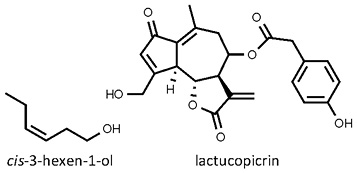 Lactuca sativa
Lactuca sativa
lettuce
Lactuca sativa L. (Asteraceae); blaarslaai (Afrikaans); sheng cai (Chinese); laitue (French); Gartensalat (German); lattuga (Italian); selada (Malay); alface (Portuguese); lechuga (Spanish)
DESCRIPTION The most popular types include leaf lettuce (looseleaf, cutting and bunching types), romaine or cos lettuce (long upright heads) and crisphead lettuce (“iceberg” type, popular in the United States). Less well known are butterhead, summercrisp, stem and oilseed lettuces. Lettuce leaves have a very high water content (ca. 95%) and are almost invariably eaten fresh.
THE PLANT An annual with soft leaves that exude milky latex from the thick leaf midribs.
ORIGIN Mediterranean region and the Near East. Lettuce is a cultigen derived from wild lettuce (L. serriola).1 It was initially grown for seeds in Egypt (since 4500 BC), and only later as a leaf crop.1 Lettuce is the most popular of all salad leaves, with annual production estimated to exceed 23 million tons worldwide.
CULTIVATION Lettuce is an annual crop, propagated from seeds. It is best grown in full sun, in well-drained, nitrogen-rich soil under cool conditions. Heat causes bolting (and a bitter taste).
HARVESTING Heads of lettuce (or loose leaves) are picked in the early morning and rapidly transported to the market.
CULINARY USES Lettuce is usually classified as a vegetable but it can also be regarded as a culinary herb because it is almost invariably eaten fresh and adds subtle flavours to the salad in which it is usually the main ingredient. Lettuce leaves are added (either tossed or composed) to green salads and mixed salads of which there are countless variations all over the world.2 Caesar, Greek, Niçoise and Waldorf salads are famous examples. A Caesar salad is made from romaine (cos) lettuce with croutons, Parmesan cheese, lemon juice, raw or coddled egg, Worcestershire sauce, garlic and black pepper. Its creation is attributed to the Italian American restaurateur Caesar Cardini. A typical Greek salad has tomato wedges, cucumber, green bell pepper, onion, feta cheese and kalamata olives, is seasoned with salt, black pepper and dried oregano and dressed with olive oil. The term “Greek salad” is also used in the United States, Australia, South Africa and the United Kingdom to refer to a lettuce-based salad with the aforementioned ingredients, and dressed with oil and vinegar. A Niçoise salad (named after the city of Nice) is made from romaine lettuce, Niçoise olives and anchovies, served with Dijon vinaigrette. A Waldorf salad is traditionally made from fresh apple, celery and walnuts, dressed with mayonnaise and served on a bed of lettuce. It was first created in the 1890s at the Waldorf Hotel in New York City. Lettuce is a popular garnish (e.g. on hamburgers) and may be braised, stuffed, puréed, cooked or served as a chiffonnade (chopped, softened in butter, with stock, milk or cream added).2
FLAVOUR COMPOUNDS The main aroma compound of fresh lettuce leaves is cis-3-hexen-1-ol, a compound responsible for the distinctive smell of freshly mown lawn grass.3 The bitter taste of lettuce (and endives) is due to lactucopicrin and related minor sesquiterpene lactones.4

NOTES A few examples of other salad herbs are also shown opposite.
1. Zohary, D., Hopf, M. 2012. Domestication of plants in the Old World. Clarendon Press, Oxford.
2. Larousse. 1999. The concise Larousse gastronomique. Hamlyn, London.
3. Arey, J., Winer, A.M., Atkinson, R., Aschman, S.M., Morrison, C.L. 1991. The emission of (Z)-3-hexen-1-ol, hexenylacetate and other oxygenated hydrocarbons from agricultural plant species. Atmospheric Environment 5/6: 1063–1076.
4. Seo, M.W., Yang, D.S., Kays, S.J., Lee, G.P., Park, K.W. 2009. Sesquiterpene lactones and bitterness in Korean leaf lettuce cultivars. HortScience 24: 246–249.